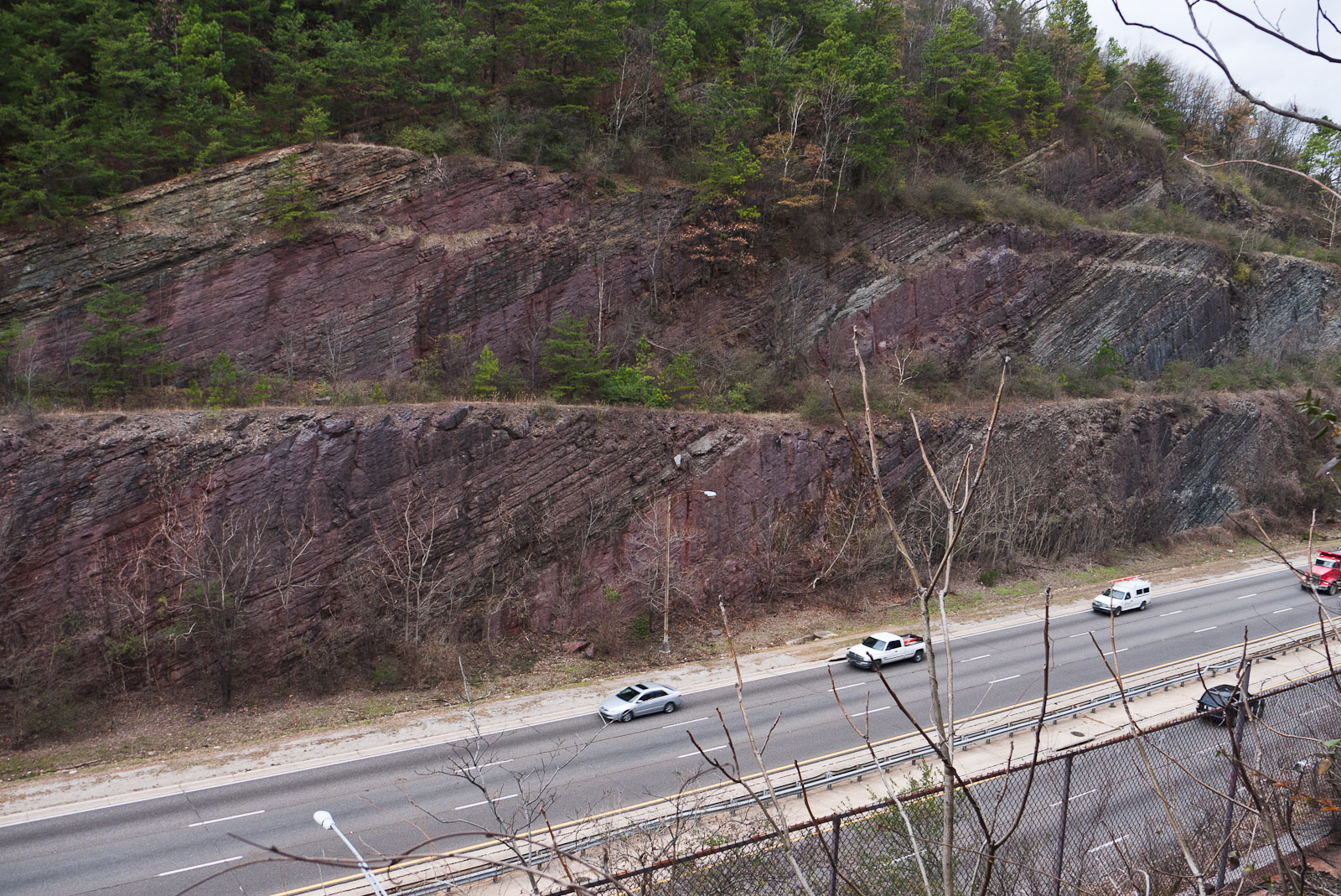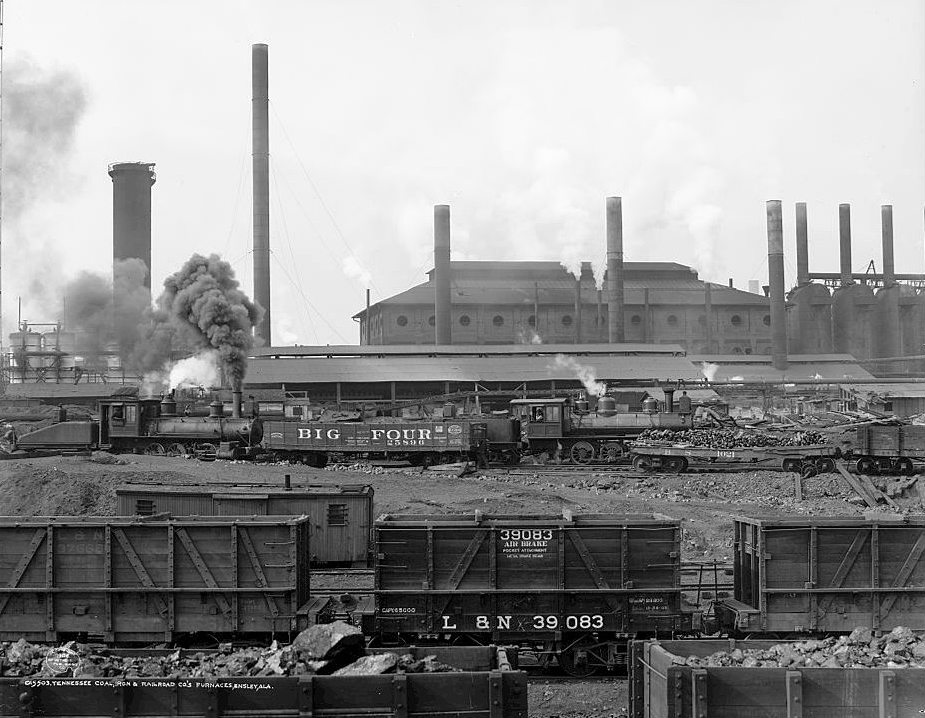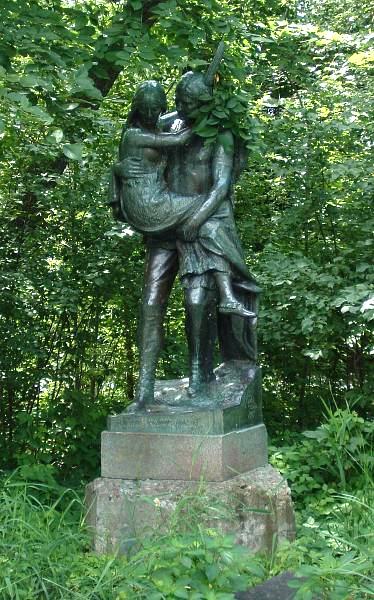|
Wenonah, Alabama
The Wenonah community (formerly Fossil) was the name of one of a series of Red Mountain ore mining camps for employees of the Tennessee Coal and Iron Company (TCI). Name The name was chosen by TCI's social science director Marion Whidden as a complement to the company's Ishkooda and Muscoda camps. All three names appear in Henry Wadsworth Longfellow's epic poem "The Song of Hiawatha".In the poem, Wenonah (from Dakota Sioux "winona" meaning "first-born daughter") is the daughter of Nokomis and mother of Hiawatha. Ishkooda (from Ojibwe Chippewa "ishkode" meaning fire) is a comet. And Muskoday (from Ojibwe Chippewa "mashkode" meaning "prairie") is a meadow The TCI camps were designated from west to east as: Muscoda Division Camp - mines #1, #2, #3, #4, #5, #6, Wenonah Division Camp ( originally referred to as the TCI Fossil Division ) mines #6½ #7, #8, #9, #10 and the Ishkooda Division Camp - mines #11, #12, #13, #14, #15. History The oldest TCI mine was in the Ishkooda camp # ... [...More Info...] [...Related Items...] OR: [Wikipedia] [Google] [Baidu] |
Red Mountain (Birmingham, Alabama)
Red Mountain is a long ridge running southwest-northeast and dividing Jones Valley from Shades Valley south of Birmingham, Alabama. It is part of the Ridge-and-Valley region of the Appalachian mountains. The Red Mountain Formation of hard Silurian rock strata lies exposed in several long crests, and was named "Red Mountain" because of the rust-stained rock faces and prominent seams of red hematite iron ore. The mountain was the site of the Sloss, Republic Steel, Woodward Iron and Tennessee Coal and iron mines which supplied ore to Birmingham's iron furnaces. The best displays of the mountain's geological strata occur at the Twentieth Street cut near the Vulcan statue and at the U.S. Route 31 highway cut leading into the suburb of Homewood. Most of Birmingham's television and radio stations have their transmission towers located on Red Mountain. Red Mountain is also home to Red Mountain Park, one of the largest urban parks in the United States at . Description : At Birmingha ... [...More Info...] [...Related Items...] OR: [Wikipedia] [Google] [Baidu] |
Tennessee Coal, Iron And Railroad Company
The Tennessee Coal, Iron and Railroad Company (1852–1952), also known as TCI and the Tennessee Company, was a major American steel manufacturer with interests in coal mining, coal and iron ore mining and railroad operations. Originally based entirely within Tennessee, it relocated most of its business to Alabama in the late nineteenth century, following protests over its use of free convict labor. With a sizable real estate portfolio, the company owned several Birmingham satellite towns, including Ensley (Birmingham), Ensley, Fairfield, Alabama, Fairfield, Docena, Alabama, Docena, Edgewater, Alabama, Edgewater and Bayview, Alabama, Bayview. It also established a coal mining camp it sold to U.S. Steel which developed it into the Westfield, Alabama planned community. At one time the second largest steel producer in the United States, TCI was listed on the first Dow Jones Industrial Average in 1896. However, in 1907, the company was merged with its principal rival, the United State ... [...More Info...] [...Related Items...] OR: [Wikipedia] [Google] [Baidu] |
The Song Of Hiawatha
''The Song of Hiawatha'' is an 1855 epic poem in trochaic tetrameter by Henry Wadsworth Longfellow which features Native American characters. The epic relates the fictional adventures of an Ojibwe warrior named Hiawatha and the tragedy of his love for Minnehaha, a Dakota woman. Events in the story are set in the Pictured Rocks area of Michigan on the south shore of Lake Superior. Longfellow's poem is based on oral traditions surrounding the figure of Manabozho, but it also contains his own innovations. Longfellow drew some of his material from his friendship with Ojibwe Chief '' Kahge-ga-gah-bowh'', who would visit at Longfellow's home. He also had frequent encounters with Black Hawk and other Sauk people on Boston Common, and he drew from ''Algic Researches'' (1839) and other writings by Henry Rowe Schoolcraft, an ethnographer and United States Indian agent, and from ''Heckewelder's Narratives''. In sentiment, scope, overall conception, and many particulars, Longfellow insi ... [...More Info...] [...Related Items...] OR: [Wikipedia] [Google] [Baidu] |
Woodward Iron Company
The Woodward Iron Company (located in the area between Hueytown, Brighton, and Bessemer, Alabama) was founded on December 31, 1881, by brothers William and Joseph Woodward. William was the company president and Joseph was the company secretary.Marjorie L. White, ''The Birmingham District, An Industrial History and Guide'' (1981) The company operated iron and coal mines, quarries and furnaces; these were connected by a private industrial railroad based in Bessemer, Alabama. The company administrative office was located near Woodward Ore Mine #1, south of Paul's Hill in Bessemer. By the 1920s Woodward Iron was one of the nation's largest suppliers of pig iron. It was part of the industrial complex of heavy industries in the Birmingham and Bessemer area. The workforce eventually grew to more than 2000 men. In 1968, Mead Corporation acquired Woodward Iron Company just as the nation's steel industry was about to begin restructuring and a long decline. By the mid 1970s the entire ... [...More Info...] [...Related Items...] OR: [Wikipedia] [Google] [Baidu] |
Water Reservoir
A reservoir (; from French ''réservoir'' ) is an enlarged lake behind a dam. Such a dam may be either artificial, built to store fresh water or it may be a natural formation. Reservoirs can be created in a number of ways, including controlling a watercourse that drains an existing body of water, interrupting a watercourse to form an embayment within it, through excavation, or building any number of retaining walls or levees. In other contexts, "reservoirs" may refer to storage spaces for various fluids; they may hold liquids or gasses, including hydrocarbons. ''Tank reservoirs'' store these in ground-level, elevated, or buried tanks. Tank reservoirs for water are also called cisterns. Most underground reservoirs are used to store liquids, principally either water or petroleum. Types Dammed valleys Dammed reservoirs are artificial lakes created and controlled by a dam constructed across a valley, and rely on the natural topography to provide most of the basin of the re ... [...More Info...] [...Related Items...] OR: [Wikipedia] [Google] [Baidu] |
Water Tank
A water tank is a container for storing water. Water tanks are used to provide storage of water for use in many applications, drinking water, irrigation agriculture, fire suppression, agricultural farming, both for plants and livestock, chemical manufacturing, food preparation as well as many other uses. Water tank parameters include the general design of the tank, and choice of construction materials, linings. Various materials are used for making a water tank: plastics (polyethylene, polypropylene), fiberglass, concrete, stone, steel (welded or bolted, carbon, or stainless). Earthen pots, such as matki used in South Asia, can also be used for water storage. Water tanks are an efficient way to help developing countries to store clean water. History Throughout history, wood, ceramic and stone tanks have been used as water tanks. These containers were all naturally occurring and some man made and a few of these tanks are still in service. The Indus Valley civilization (30 ... [...More Info...] [...Related Items...] OR: [Wikipedia] [Google] [Baidu] |
Lipscomb, Alabama
Lipscomb is a city in western Jefferson County, Alabama. It is part of the Birmingham, Alabama, metropolitan area. At the 2020 census, the population was 2,086. It does not have its own U.S. Post Office or ZIP code, instead sharing the Bessemer ZIP code (35020). Geography Lipscomb is located at (33.427308, -86.922475). According to the U.S. Census Bureau, the town has a total area of , all land. Demographics 2000 census At the 2000 census, there were 2,458 people, 901 households, and 634 families living in the town. The population density was . There were 1,108 housing units at an average density of . The racial makeup of the town was 32.55% White, 65.58% Black or African American, 0.28% Native American, 0.04% Asian, 0.12% Pacific Islander, 0.94% from other races, and 0.49% from two or more races. 2.24% of the population were Hispanic or Latino of any race. Of the 901 households 35.1% had children under the age of 18 living with them, 41.4% were married couples livi ... [...More Info...] [...Related Items...] OR: [Wikipedia] [Google] [Baidu] |
Jefferson County, Alabama
Jefferson County is the List of counties in Alabama, most populous county in the U.S. state of Alabama, located in the central portion of the state. As of the 2020 United States census, 2020 census, its population was 674,721. Its county seat is Birmingham, Alabama, Birmingham. Its rapid growth as an industrial city in the 20th century, based on heavy manufacturing in steel and iron, established its dominance. Jefferson County is the central county of the Birmingham-Hoover, Alabama, Hoover, AL Birmingham metropolitan area, Alabama, Metropolitan Statistical Area. History Jefferson County was established on December 13, 1819, by the Alabama Legislature. It was named in honor of former President of the United States, President Thomas Jefferson. The county is located in the north-central portion of the state, on the southernmost edge of the Appalachian Mountains. It is in the center of the (former) iron, coal, and limestone mining belt of the Southern United States. Most of the ... [...More Info...] [...Related Items...] OR: [Wikipedia] [Google] [Baidu] |
Iron Ore
Iron ores are rocks and minerals from which metallic iron can be economically extracted. The ores are usually rich in iron oxides and vary in color from dark grey, bright yellow, or deep purple to rusty red. The iron is usually found in the form of magnetite (, 72.4% Fe), hematite (, 69.9% Fe), goethite (, 62.9% Fe), limonite (, 55% Fe) or siderite (, 48.2% Fe). Ores containing very high quantities of hematite or magnetite (greater than about 60% iron) are known as "natural ore" or "direct shipping ore", meaning they can be fed directly into iron-making blast furnaces. Iron ore is the raw material used to make pig iron, which is one of the main raw materials to make steel—98% of the mined iron ore is used to make steel. In 2011 the ''Financial Times'' quoted Christopher LaFemina, mining analyst at Barclays Capital, saying that iron ore is "more integral to the global economy than any other commodity, except perhaps oil". Sources Metallic iron is virtually unknown on ... [...More Info...] [...Related Items...] OR: [Wikipedia] [Google] [Baidu] |
Birmingham District
The Birmingham District is a geological area in the vicinity of Birmingham, Alabama, where the raw materials for making steel, limestone, iron ore, and coal are found together in abundance. The district includes Red Mountain, Jones Valley, and the Warrior and Cahaba coal fields in Central Alabama. Industrial development The industrial development of these resources began, in limited fashion, before the American Civil War (attracting the attention of Wilson's Raiders in the course of that conflict). Beginning in 1871 with the founding of the City of Birmingham and the construction of the first blast furnaces, the development of the district enjoyed explosive growth, slowed only by a deficit of skilled labor and investment capital. This boom earned for Birmingham the nicknames "The Magic City" and "Pittsburgh of the South", and also spurred the growth of several independent industrial cities and dozens of company towns. By the end of the 19th century, Birmingham was the third ... [...More Info...] [...Related Items...] OR: [Wikipedia] [Google] [Baidu] |
Venezuela
Venezuela (; ), officially the Bolivarian Republic of Venezuela ( es, link=no, República Bolivariana de Venezuela), is a country on the northern coast of South America, consisting of a continental landmass and many islands and islets in the Caribbean Sea. It has a territorial extension of , and its population was estimated at 29 million in 2022. The capital and largest urban agglomeration is the city of Caracas. The continental territory is bordered on the north by the Caribbean Sea and the Atlantic Ocean, on the west by Colombia, Brazil on the south, Trinidad and Tobago to the north-east and on the east by Guyana. The Venezuelan government maintains a claim against Guyana to Guayana Esequiba. Venezuela is a federal presidential republic consisting of 23 states, the Capital District and federal dependencies covering Venezuela's offshore islands. Venezuela is among the most urbanized countries in Latin America; the vast majority of Venezuelans live in the cities of the n ... [...More Info...] [...Related Items...] OR: [Wikipedia] [Google] [Baidu] |
Iron Mines In The United States
Iron () is a chemical element with Symbol (chemistry), symbol Fe (from la, Wikt:ferrum, ferrum) and atomic number 26. It is a metal that belongs to the first transition series and group 8 element, group 8 of the periodic table. It is, Abundance of the chemical elements#Earth, by mass, the most common element on Earth, right in front of oxygen (32.1% and 30.1%, respectively), forming much of Earth's outer core, outer and inner core. It is the fourth most common abundance of elements in Earth's crust, element in the Earth's crust. In its metallic state, iron is rare in the Earth's crust, limited mainly to deposition by meteorites. Iron ores, by contrast, are among the most abundant in the Earth's crust, although extracting usable metal from them requires kilns or Metallurgical furnace, furnaces capable of reaching or higher, about higher than that required to smelting, smelt copper. Humans started to master that process in Eurasia during the 2nd millennium BC, 2nd millennium BCE ... [...More Info...] [...Related Items...] OR: [Wikipedia] [Google] [Baidu] |





